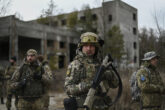March 01, 2020
The Building Blocks of a Progressive Transatlantic Vision
As the US presidential elections in November 2019 quickly approach, transatlanticists in the United States and Europe are trying to decipher what the next four years may bring for the US-European partnership. A second term for Donald Trump means that the difficulties that have plagued the relationship for the last three years will almost certainly continue. A Democrat entering office, on the other hand, could provide an opportunity for a clean slate. No matter who ultimately claims victory at the polls, one thing is certain: The US-European relationship needs a makeover; a progressive vision that places new priorities at the forefront of transatlantic cooperation; one that lays the foundation for the two sides to jointly tackle the most important issues of our time. But what exactly, would this vision look like?
First and foremost, a progressive vision means elevating the status of the US-European Union (EU) relationship. For decades, the foundation of the US-European partnership has been the NATO alliance, which has over-militarized transatlantic relations and prioritized a narrow vision of security and defense. The two sides often get sidetracked debating issues like European defense spending and how to counter Russia. While these issues are important, they are by no means the most important. There other aspects of today's geopolitical landscape that will prove to be more consequential in the years to come; issues that NATO does not exist to tackle, and which, instead, will require deeper and more meaningful cooperation between the US and the EU. At the top of the list are climate change, a rising China, and a recommitment to human rights.
Read the full essay in the Heinrich Böll Foundation's Multilateralism 2.0 compendium.
More from CNAS
-
Ukraine Negotiations: Prospects and Pitfalls of Peace
This week Brussels Sprouts breaks down the latest negotiations on Ukraine. American officials told reporters that they had resolved or closed gaps around 90 percent of their d...
By Andrea Kendall-Taylor & Jim Townsend
-
Transatlantic Security / Middle East Security
The Russia-Iran Partnership: A Geopolitical Balancing ActIt has been almost a year since Russia and Iran signed their comprehensive strategic partnership. That deal established a 20-year partnership between the two countries coverin...
By Andrea Kendall-Taylor & Jim Townsend
-
Defense / Transatlantic Security
Ukraine’s Catch-22 MomentThis article was originally published in the Financial Times. In Joseph Heller’s wartime classic, Catch-22, the protagonist Yossarian seeks out the US army surgeon Doc Daneeka...
By Franz-Stefan Gady
-
Ex-Nato Supreme Allied Commander Warns of Russia’s Territorial Ambitions
Gen. Philip Breedlove (Ret.), member of the CNAS board of advisors, told Fox News Digital he sees “a lot of truth” in the German foreign minister’s warning about Russia, sayin...
By Philip Breedlove




